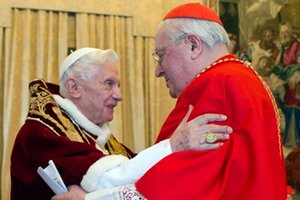Media Play down Pope Benedict's Role in Sex Abuse Scandals
By Greg Mitchell
Just last week, HBO aired the excellent new Alex Gibney documentary Mea Maxima Culpa, which focused on priestly abuse and cover-up at a Wisconsin school for the deaf, but also exposed the former Cardinal Ratzinger as the man in charge of the abuse files for years (and other failures of omission or commission). I joked yesterday that the pope had announced that he was resigning “to spend more time with his family… of priestly abuse documents.” And Gibney tweeted, “Grim Reminder: LA’s Cardinal Mahony, who did so much to shield sex abusers, is part of conclave to elect new Pope.” (Story here.) Most major media accounts did mention the sex abuse scandals in passing—how could they not?—but few made any mention that Benedict/Ratzinger may have contributed to them via inaction. The New York Times’s front-page story today, for example, runs for twenty-three paragraphs without mentioning a word of it. The media may not have focused on all this, but advocacy and victims’ organizations did. In Wisconsin, SNAP (Survivors Network of Those Abused by Priests) declared that a new pope must do what Benedict did not: Pope Benedict, who announced today he will resign on February 28, will leave his tenure as Pope without having made the one, simple moral and executive decision that would have, in a single stroke of his pen, protected potentially millions of children from harm, brought justice to hundreds of thousands of victims, and finally turned the church on a path towards true recovery and reform: worldwide zero tolerance of child sex abuse by priests. Because he never issued this decree, Benedict leaves office not only with countless children at risk around the world but scores of Cardinals and bishops in leadership positions who are actively covering up child sex abuse. Amazingly, across the world today, although there was a modification in church law allowed by the Vatican for the United States, if you are a priest and have been found by your bishop to have raped or sexually assaulted a child, you can remain in the priesthood and in ministry, your crimes left secret and unpunished. Please support our journalism. Get a digital subscription for just $9.50! Some media outlets did follow today with op-eds or editorials focusing on the abuse issue, though rarely on Benedict’s likely guilt. Jason Barry in The New York Times, for example, called on Benedict to at least take one positive step before he exited—forcing out Cardinal Angelo Sodano (in photo with the pope at upper left), who was a central figure in the “coverup” (long agreed to by Benedict) in the Gibney film. Sodano, the dean of the College of Cardinals, was the man, Barry wrote, “who, more than any other, embodies the misuse of power that has corrupted the church hierarchy.” But he added: “Cardinal Sodano is hardly alone: a long list of leaders betrayed Catholics everywhere with their pathological evasions, sending known sex offenders into treatment centers to avoid the law, then planting them in parishes or hospitals where they found new victims.” Should the media have published hacked e-mails from George W. Bush, including self-portraits of him in the shower? George Mitchell weighs in.
|
.
Any original material on these pages is copyright © BishopAccountability.org 2004. Reproduce freely with attribution.
